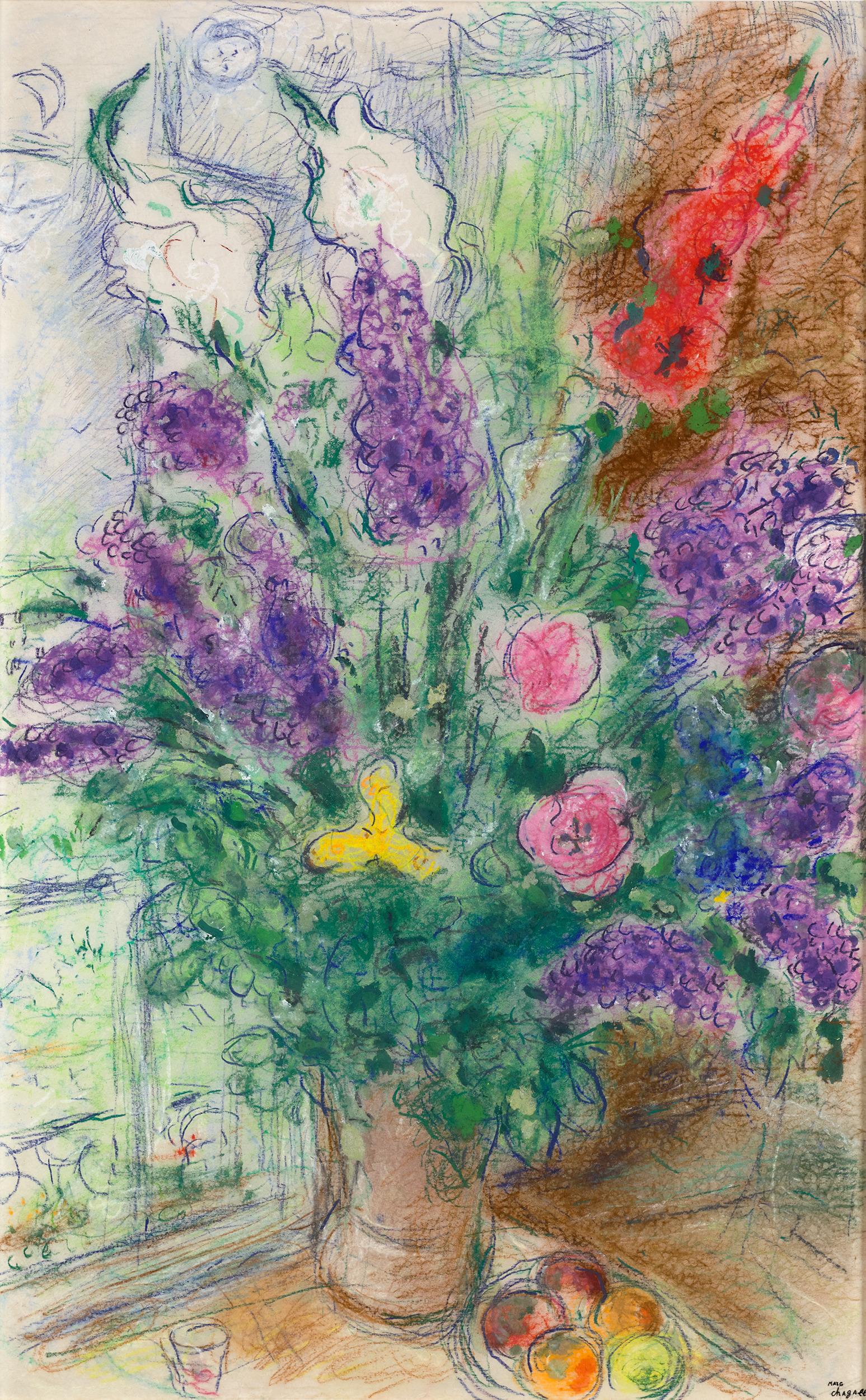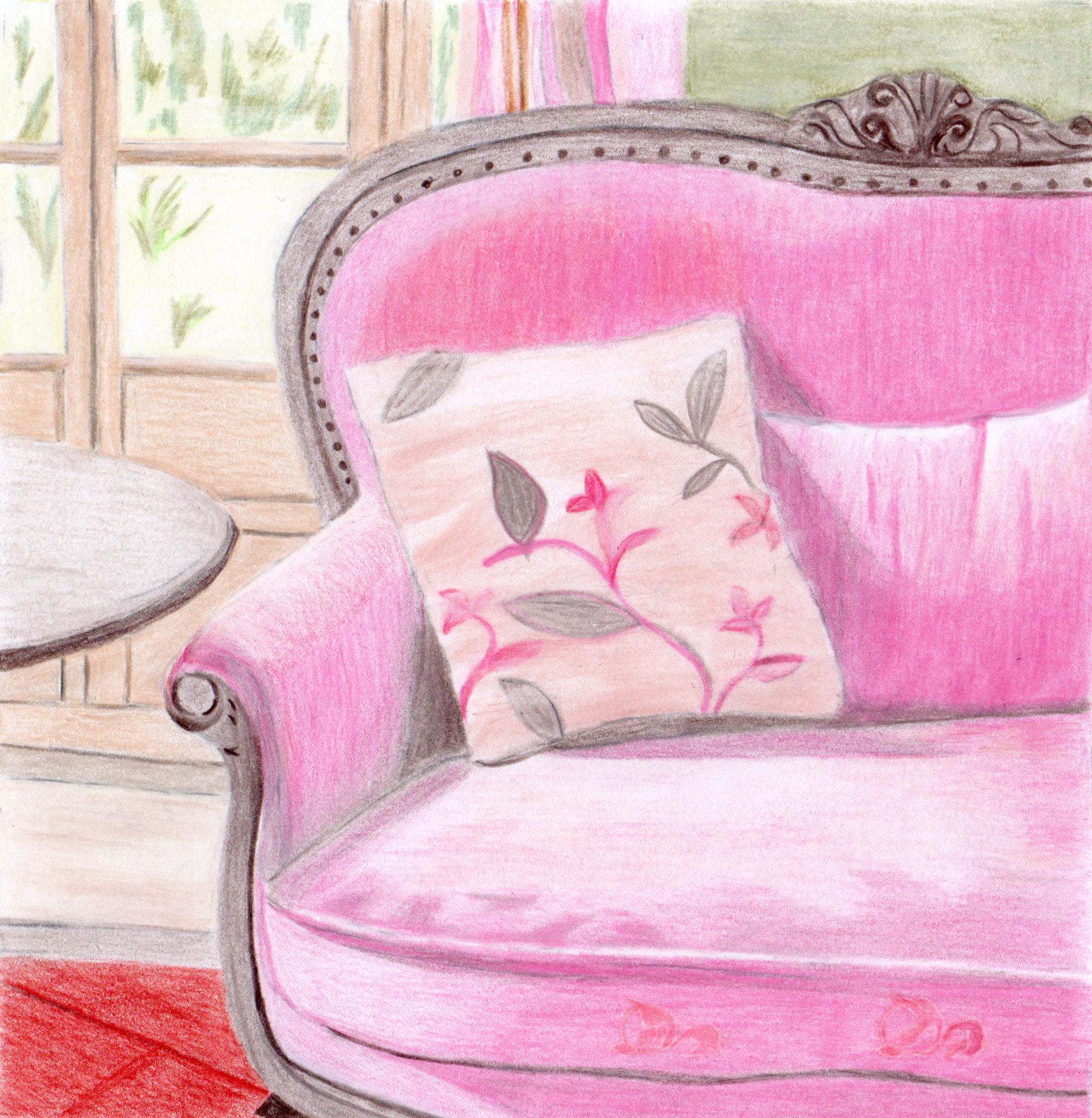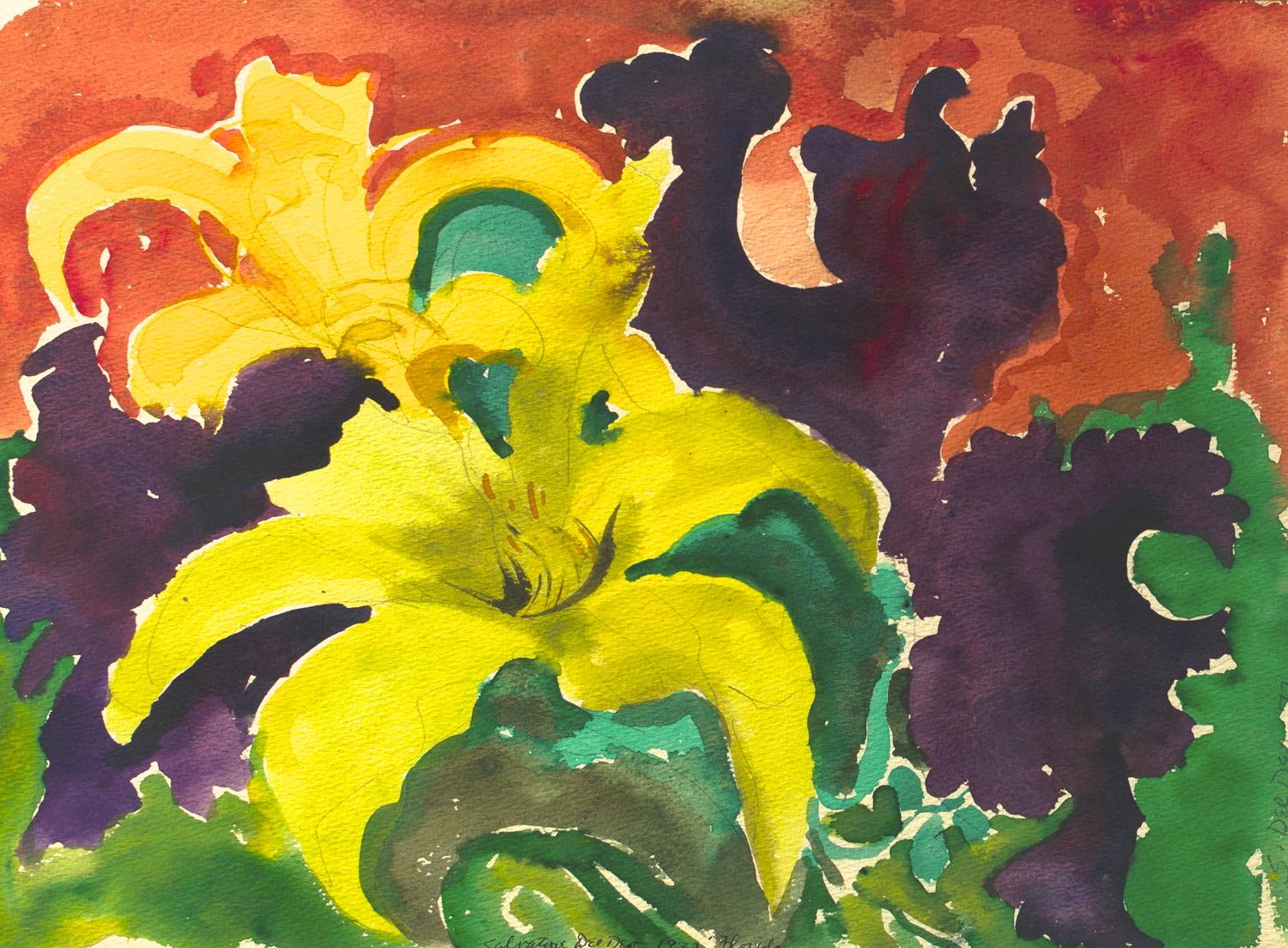Items Similar to Morning Glory and Poppy Floral - British art Old Master flower painting W/C
Want more images or videos?
Request additional images or videos from the seller
UnknownMorning Glory and Poppy Floral - British art Old Master flower painting W/CCirca 1800
Circa 1800
About the Item
This charming Old Master circa 1800 water colour painting is of morning glory flowers and tendrils entwined with a poppy. The foliage has a metallic green tone and the white morning glory is tinged with blue. The artist is suggesting the passing of time with the flowers beginning to turn brown on the edges. A lovely British Old Master composition.
Provenance. Geo. L Brown label verso with provenance details.
From Sir George Prescott's collection, details verso.
Condition. Watercolour on paper, 14 inches by 11 inches and in good condition.
Frame. Housed behind glass in an ornate period gilt frame, 21 inches by 18 inches and in good condition.
- Creation Year:Circa 1800
- Dimensions:Height: 21 in (53.34 cm)Width: 18 in (45.72 cm)Depth: 2 in (5.08 cm)
- Medium:
- Movement & Style:Old Masters
- Period:1800-1809
- Condition:
- Gallery Location:London, GB
- Reference Number:1stDibs: LU853113245362
About the Seller
5.0
Platinum Seller
These expertly vetted sellers are 1stDibs' most experienced sellers and are rated highest by our customers.
1stDibs seller since 2018
400 sales on 1stDibs
Typical response time: <1 hour
- ShippingRetrieving quote...Ships From: London, United Kingdom
- Return PolicyA return for this item may be initiated within 14 days of delivery.
More From This SellerView All
- Irises and Roses in Basket - Italian 19th Century art floral still life paintingBy Ermocrate BucchiLocated in London, GBThis lovely floral is an original and very rare to find large watercolour. It is a stunning floral arrangement by famous Italian floral artist Ermocrate Bucchi. Bucchi is a well list...Category
19th Century Impressionist Still-life Drawings and Watercolors
MaterialsWatercolor
- Village Scene Figures & Animals - British Old Master exh pastoral oil paintingBy James WardLocated in London, GBThis stunning British Old Master exhibited pastoral oil on panel is by noted artist James Ward. Painted circa 1815 with superb provenance, it was exhibited posthumously at the Royal ...Category
1810s Old Masters Animal Paintings
MaterialsOil
- Amsterdam Harbour Scene with Figures Dutch 17th Century art marine oil paintingLocated in London, GBThis superb Dutch 17th century Golden Age Old Master cityscape oil painting of Amsterdam is by noted artist Jacobus Storck. Painted circa 1670, the composition is a Dutch Amsterdam h...Category
17th Century Old Masters Landscape Paintings
MaterialsOil
- Portrait of Lady in Silver Dress - Dutch Old Master art portrait oil paintingBy Willem WissingLocated in London, GBThis lovely Dutch Old Master portrait oil painting is attributed to circle of Willem Wissing. Wissing settled in England and emerged as Peter Lely's most important pupil after his de...Category
17th Century Old Masters Portrait Paintings
MaterialsOil
- Madonna and Child with St Catherine and Putti - Italian 17thC art oil paintingBy Giuseppe Bartolomeo ChiariLocated in London, GBThis stunning Italian 17th century Old Master religious oil painting is by Baroque artist Giuseppe Bartolomeo Chari. Painted circa 1684 it is a large and vibrant oil painting of the Madonna and child. To their left is Saint Catherine and to their right four putti or cherubs look upon a sleeping Jesus. The detail in all the figures faces and hair and the colouring is just superb, especially the Madonna's sumptuous blue robe. A really fabulous 17th century religious work with previous full attribution and excellent provenance which was once attributed to Carlo Maratta (1625-1713). Provenance. With Vangelisti, Lucca, Italy, 1966, from whom acquired by the family of the previous owner, and thence by descent. Red seal stamp verso Christies April 15th 1912 Christies March 23 1956 Condition. Oil on Canvas. Image size 44 x 54 inches unframed and in good condition. Frame. Housed in an original Carlo Maratta frame, 62 inches by 52 inches framed and in good condition. Giuseppe Bartolomeo Chiari (1654-1727), also known simply as Giuseppe Chiari, was an Italian painter of the late-Baroque period, active mostly in Rome. Born in Rome, he was one of the main assistants, along with Giuseppe Passeri and Andrea Procaccini, in the studio of an elder Carlo Maratta. His father had opposed the career, but his mother, on the recommendation of a painter named Carlo Antonio Gagliani. By the age of 22, he had frescoed the lateral lunettes (Birth of Virgin and Adoration of Magi...Category
17th Century Old Masters Portrait Paintings
MaterialsOil
- Travellers and Carriage in Landscape Dutch 17th century Golden Age oil paintingLocated in London, GBThis superb Dutch Old Master Golden Age oil painting is attributed to Pieter Bodding van Laer. Painted circa 1635 the composition is a group of travellers who have stopped to rest. I...Category
17th Century Old Masters Landscape Paintings
MaterialsOil
You May Also Like
- Garden FlowersBy Charles DemuthLocated in New York, NYCharles Demuth was one of the most complex, talented, and deeply sensitive artists of the American modern period. Whether he was painting floral still lifes, industrial landscapes, or Turkish bathhouses, art was, for Demuth, fraught with personal meaning. A fixture of the vanguard art scene in New York, Demuth navigated the currents of Modernism, producing some of the most exquisite watercolors and original oil paintings in twentieth-century American art. Demuth was born in Lancaster, Pennsylvania, the only child of a well-to-do family. He had an awkward and introverted childhood shaped by a childhood illness, Perthes, a disease of the hip that not only left him permanently lame, but, as part of the “cure,” bedridden for two years in the care of his mother. This long period of incapacitation had a deep impact on Demuth, who came to see himself as an invalid, an outsider who was different from everyone else. It was perhaps during this period of indoor confinement that his keen interest in art developed. Several relatives on his father’s side had been amateur artists, and, following his convalescence, his mother encouraged his artistic pursuits by sending him to a local painter for instruction. The majority of his early pictures are of flowers, a subject for which Demuth maintained a lifelong passion. Following high school, Demuth enrolled at the Drexel Institute of Art in Philadelphia, a school renowned for its commercial arts program. He advanced through the program rapidly, and, in 1905, at the encouragement of his instructors, he began taking courses at the Pennsylvania Academy of the Fine Arts. The two leading teachers then at the Academy were William Merritt Chase and Thomas Anshutz. Anshutz, himself a former student of Thomas Eakins, was well liked by his students, and is best known as the teacher of Robert Henri, John Sloan, and several of the other artists of the Ashcan School. Demuth, too, adopted a similar idiom, working in a controlled, realistic manner while at the Academy, where he remained until 1910. In 1907, Demuth made his first trip to Europe, staying in Paris. He spent time on the periphery of the art scene composed of the numerous American artists there, including John Marin and Edward Steichen. He returned to Philadelphia five months later, and immediately resumed courses at the Academy. Despite his introduction to advanced modern styles in Europe, Demuth’s work of this period retains the academic style he practiced before the trip. It wasn’t until he had summered at New Hope, Pennsylvania, in 1908 and 1911, that his style began to evolve. New Hope was a prominent American Impressionist art colony whose members were largely affiliated with the Pennsylvania Academy. Demuth dropped the conservative tone of his style and adopted a freer and more colorful palette. Although he remained based in Philadelphia, Demuth frequently went to New York during this period. Many of the same American artists of the Parisian art scene Demuth had encountered on his earlier European trip now formed the nucleus of New York’s avant-garde, which centered around Alfred Stieglitz’s 291 gallery. It wasn’t long before Demuth began to apply modernist-inspired strategies to his work. He was particularly influenced by the watercolor work of John Marin, also a former student of Anshutz, whose bold use of color in the medium Demuth freely adapted into looser washes of color. In 1912, Demuth again left for Paris, this time studying in the Académie Moderne, Académie Colorossi, and Académie Julian. In Paris Demuth met the American modernist Marsden Hartley. Hartley, a principal figure in the expatriate art circle, acted as a mentor to Demuth, and introduced him to the wide array of modern styles currently practiced in Europe. Hartley also introduced Demuth to many of the members of the Parisian avant-garde, including Gertrude Stein. Demuth was an aspiring writer, and he spent many hours in conversation with Stein. He wrote extensively during this period, and published two works shortly after his return to America. He also developed an interest in illustrating scenes from literary texts. From 1914 to 1919, Demuth produced a series of watercolors of scenes from books such as Emile Zola’s Nana and Henry James’s The Turn of the Screw. Upon his return to America, Demuth settled in New York. In 1914, Demuth had his first one-man show at Charles Daniel’s gallery, which promoted emerging modern American artists, including Man Ray, Rockwell Kent, Yasuo Kuniyoshi, Stuart Davis, and Max Weber. Demuth drew closer to the artistic vanguard in New York, becoming friends with many in the Stieglitz and Daniel circles, including Georgia O’Keeffe, Marcel Duchamp, Carl Van Vechten, and Edward Fiske. New York’s cosmopolitan atmosphere and active nightlife appealed greatly to Demuth. In a sketchy style well suited to watercolor, he painted many vaudeville and circus themes, as well as nightclub, café, and bathhouse scenes. Often with Duchamp, Demuth took part in an urban subculture replete with nightclubs, bars, drugs, and sexual permissiveness, which, for a homosexual artist like himself, allowed room for previously unattainable personal expression. Demuth’s pictures of sailors, bathhouses, and circus performers embody a sensual and sexual undercurrent, expressing the artist’s sense of comfort and belonging in the bohemian subculture of New York. Simultaneously, Demuth deepened his interest in floral pictures, painting these almost exclusively in watercolor. His style evolved from the broad color washes of his earlier pictures to more spare, flattened, and sinuous compositions, inspired by the drawings of Aubrey Beardsley and other artists of the Aesthetic Movement. Demuth’s flower watercolors are moody and atmospheric, sensuous and elegant, introspective and yet full of expressive power. Moreover they are beautiful, and are unequivocally among the finest still lifes in American art. Despite numerous subsequent artistic undertakings that led him in a variety of directions, Demuth never stopped painting flower pictures, ultimately adding fruits and other still-life objects to his repertoire. In 1916, Demuth began to develop a style later known as Precisionism, a form of landscape painting infused with Cubism, in which space is divided into precisely drawn geometric regions of color. Demuth first began to paint the landscape in an appropriated Cubist mode while on a trip with Hartley to Bermuda. In these early landscapes, in which the curvilinear forms of trees intersect the geometrically articulated architectural forms, Demuth explored ideas that shaped the future development of modernism in America. The full realization of Demuth’s explorations came after his return to America in 1917, when he turned his attention to industrial subjects. These works derive from a “machine aesthetic,” espoused by New York artists such as Francis Picabia, Joseph Stella, Albert Gleizes, and Duchamp, by which artists viewed machines as embodying mystical, almost religious significance as symbols of the modern world. Rather than painting the skyscrapers and bridges of New York as did most of his like-minded contemporaries, Demuth returned to his home town of Lancaster, where he painted factories and warehouses in a Precisionist idiom. The titles for these pictures are often contain literary references, which serve as clues for the viewer to aid in the decoding of the artist’s meaning. In 1923, Demuth planned a series of abstract “poster portraits” of his friends and contemporaries in the New York art and literary scene. In these “portraits,” Demuth combined text and symbolic elements to evoke the essential nature of his sitters’ distinguishing characteristics. In this fashion, he painted portraits of such artists as Georgia O’Keeffe, John Marin, and Arthur Dove. His most famous poster portrait, I Saw the Figure 5 in Gold...Category
20th Century American Modern Still-life Drawings and Watercolors
MaterialsPaper, Watercolor
- Mantel ClockLocated in Houston, TXFrench watercolor and pencil of ornate clock, circa 1930. Original artwork on paper displayed on a white mat with a gold border. Archival plastic sleev...Category
1930s Still-life Drawings and Watercolors
MaterialsPencil, Watercolor
- Watercolor on Paper Painting, by Charles Burchfield, 1919Located in New York, NYCharles Burchfield 1893-1967 Trilliums and Rock Ledge, 1919 Gouache and watercolor on paper Provenance: The artist until at least 1963 Private collection, New York Private Collectio...Category
1910s Landscape Drawings and Watercolors
MaterialsWatercolor, Gouache
- Grand Bouquet Et Fruits Devant La Fenêtre À Paris By Marc ChagallBy Marc ChagallLocated in New Orleans, LAMarc Chagall 1887-1985 Russian Grand bouquet et fruits devant la fenêtre à Paris (Large bouquet and fruits in front of the window in Paris) Stamped with signature “Marc Chagall" (...Category
20th Century Post-Impressionist Still-life Drawings and Watercolors
MaterialsPaper, Pastel, Gouache
- Intérieur Provence, Realistic Figurative original Drawing, Colorful, InteriorLocated in AIX-EN-PROVENCE, FRColoured Pencils and pastel on Hahnemühle paper - Realistic Figurative original Drawing, Colorful, Interior. Work Title : Intérieur Provence Artist : Gabriel Riesnert...Category
21st Century and Contemporary Contemporary Interior Drawings and Waterco...
MaterialsWatercolor, Archival Paper, Color Pencil, Pastel
- LiliesLocated in Provincetown, MASalvatore Del Deo is a painter engaged in a spirited dialogue with his work, responding to the deep questions presented by the paintings themselves. ...Category
20th Century Abstract Impressionist Still-life Drawings and Watercolors
MaterialsWatercolor




